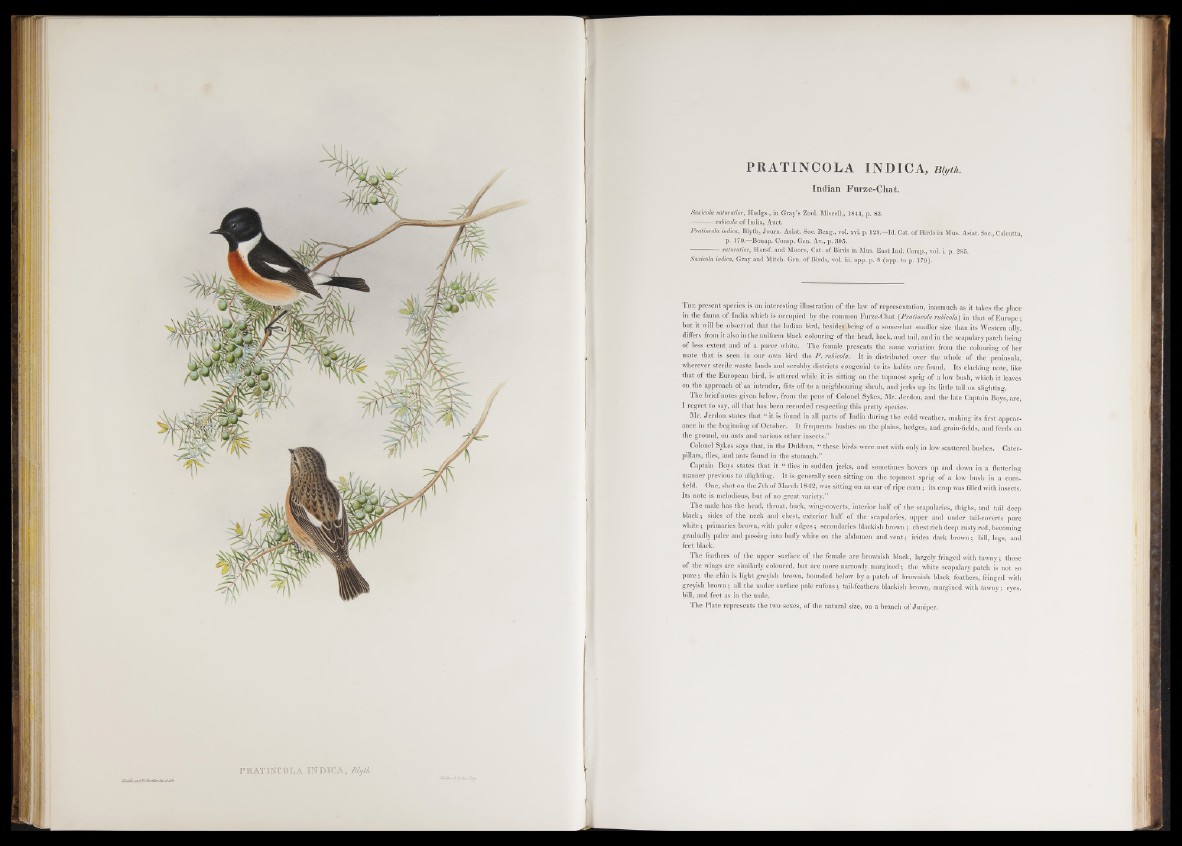
PRATINCOLA INDICA, Blyìà,.
PRATINCOLA INDICA, niyth.
India» Furze-Chat.
Saxícola saturatior, Hodgs., in Gray’s Zool. Misceli., 1844, p. 83.
rubicola of India, Auct.
Pratíncola indica, Blyth, Journ. Asiat. Soc. Beng., voi. svi. p. 129.—Id. Cat. of Birds in Mus. Asiat. Soc., Calcutta,
p. 170.—Bonap. Consp. Gen. Av., p. 305.
--------------saturatior, Horsf. and Moore, Cat. of Birds in Mus. East Ind. Comp., voi. i. p. 285.
Saxícola indica, Gray and Mitch. Gen. of Birds, voi. iii. app. p. 8 (app. to p. 179).
T h e present species is an interesting illustration o f the law o f representation, inasmuch as it takes the place
in the fauna of India which is occupied by the common Furze-Chat (.Pratíncola rubicola') in that of Europe;
hut it will be observed that the Indian bird, beside^being of a somewhat smaller size than its Western ally,
differs from it also in the uniform black colouring of the head, back, and tail, and in the scapulary patch being
of less extent and o f a purer white. The female presents the same variation from the colouring o f her
mate that is seen in our own bird the P . rubicola. I t is distributed over the whole o f the peninsula,
wherever sterile waste lands and scrubby districts congenial to its habits are found. Its clacking note, like
that of the European bird, is uttered while it is sitting on the topmost sprig o f a low bush, which it leaves
on the approach of an intruder, flits off to a neighbouring shrub, and jerks up its little tail on ali°-hting.
The brief notes given below, from the pens o f Colonel Sykes, Mr. Jerdon, and the late Captain Boys, are,
I regret to say, all that has been recorded respecting this pretty species.
Mr. Jerdon states that “ it is found in all parts of India during the cold weather, making its first appearance
in the beginning of October. I t frequents bushes on the plains, hedges, and grain-fields, and feeds on
the ground, on ants and various other insects.”
Colonel Sykes says that, in the Dukhun, “ these birds were met with only in low scattered bushes. Caterpillars,
flies, and ants found in the stomach.”
Captain Boys states that it “ flies in sudden jerks, and sometimes hovers up and down in a fluttering
manner previous to alighting; I t is generally seen sitting on the topmost sprig of a low bush in a cornfield.
One, shot on the 7th o f March 1842, was sitting on an ear o f ripe co rn ; its crop was filled with insects.
Its note is melodious, but of no great variety.”
The male has the head, throat, back, wing-coverts, interior half o f the scapularies, thighs, and tail deep
black ; sides of the neck and chest, exterior half o f the scapularies, upper and under tail-coverts pure
white; primaries brown, with paler edges ; secondaries blackish brown ; chest rich deep rusty red, becoming
gradually paler and passing into bufly white on the abdomen and v ent; irides dark brown; bill, legs, and
feet black.
The feathers o f the upper surface of the female are brownish black, largely fringed with tawny; those
of the wings are similarly coloured, but are more narrowly margined; the white scapulary patch is not so
p u r e ; the chin is light greyish brown, bounded below by a patch o f brownish black feathers, fringed with
greyish brown; all the under surface pale rufous; tail-feathers blackish brown, margined with tawny; eyes,
bill, and feet as in the male.
The Plate represents the two sexes, o f the natural size, on a branch of Juniper.